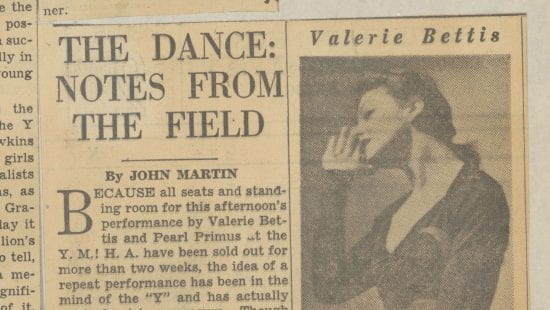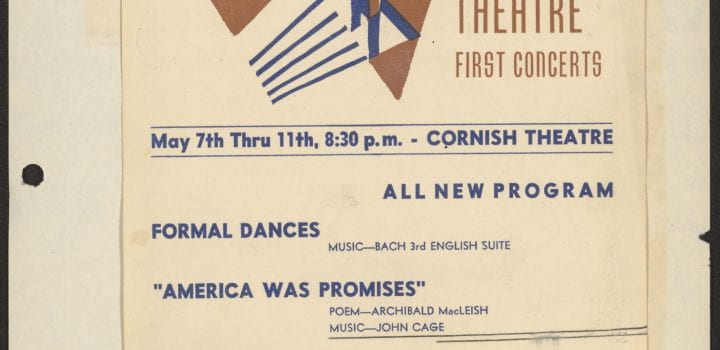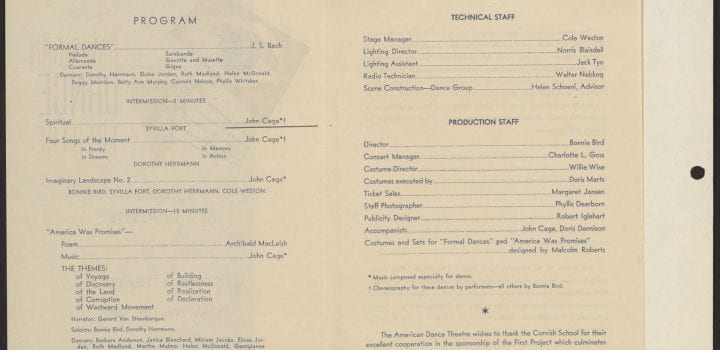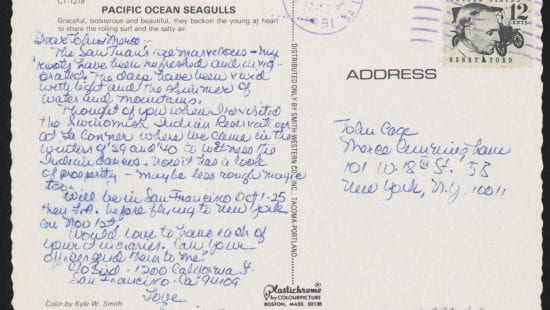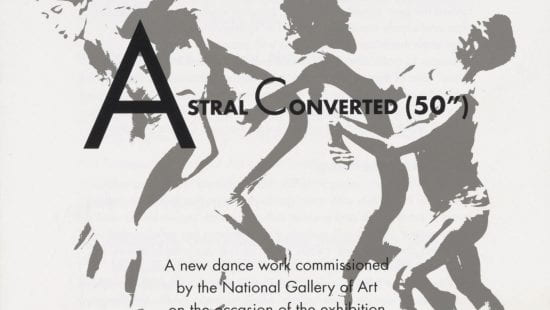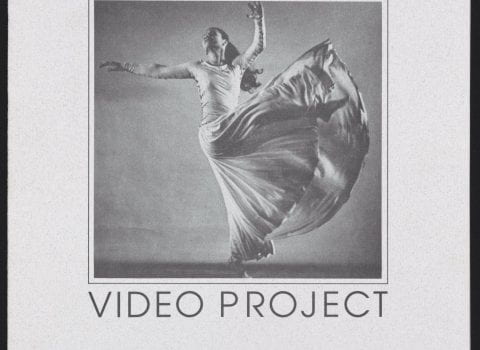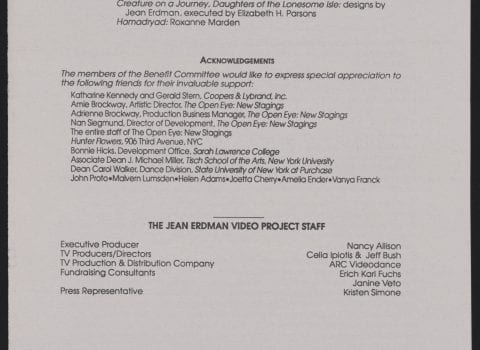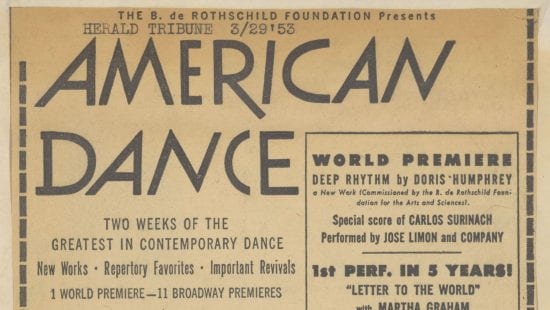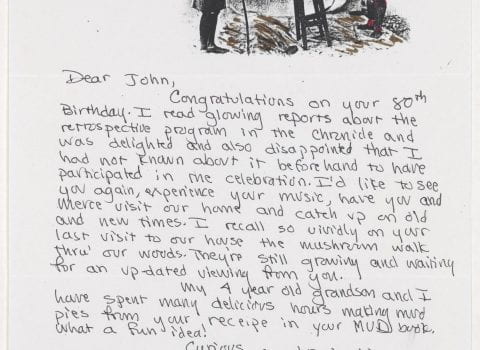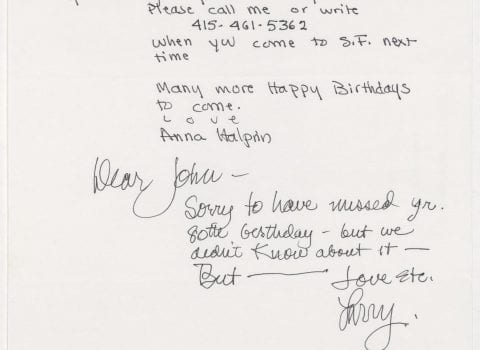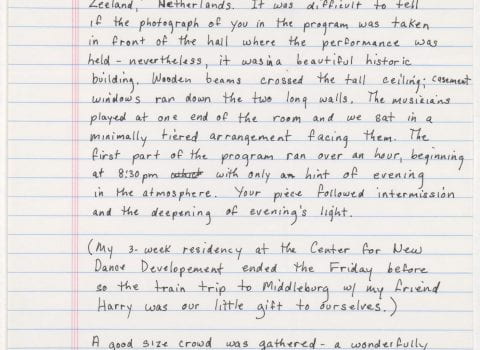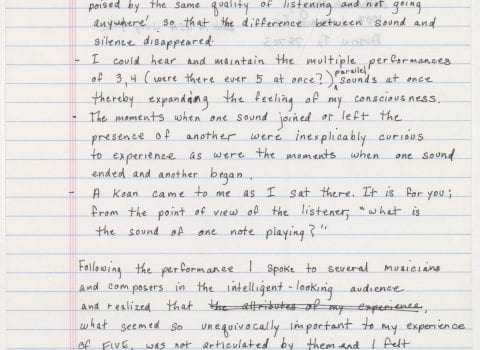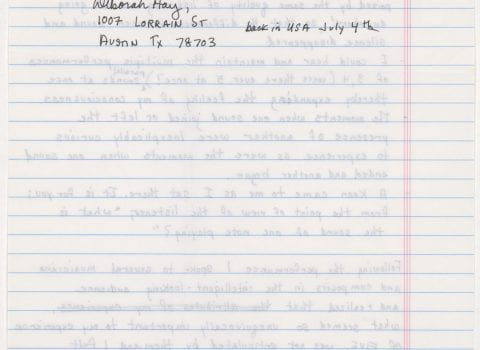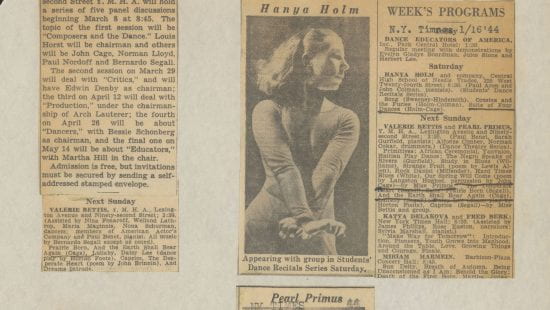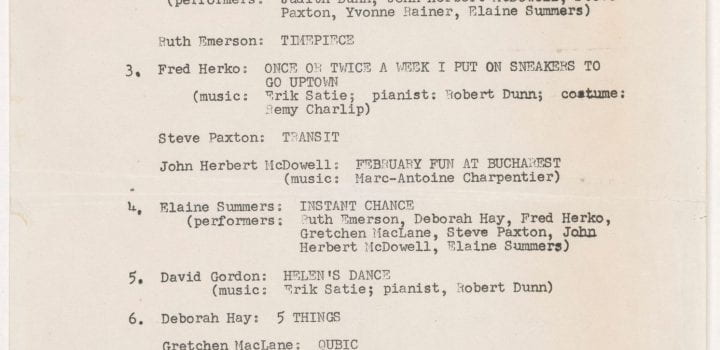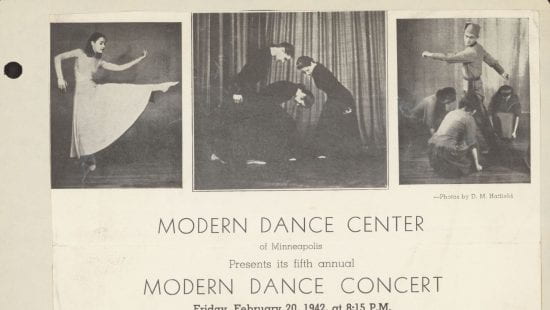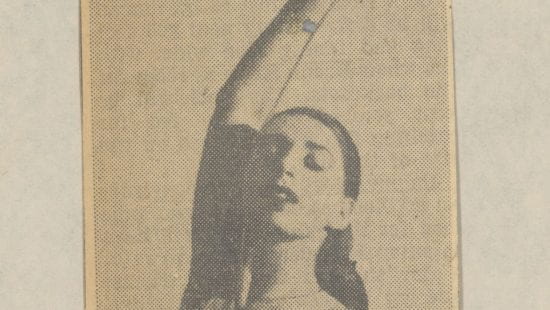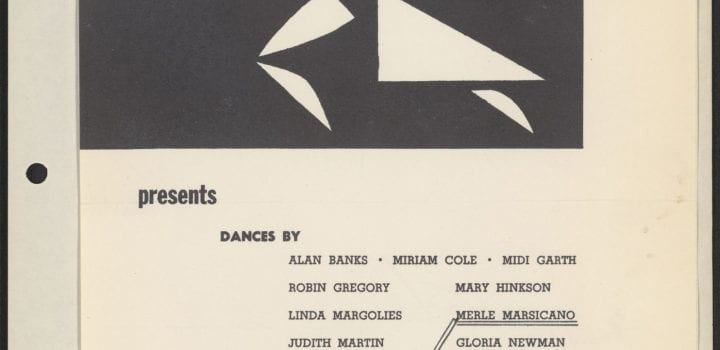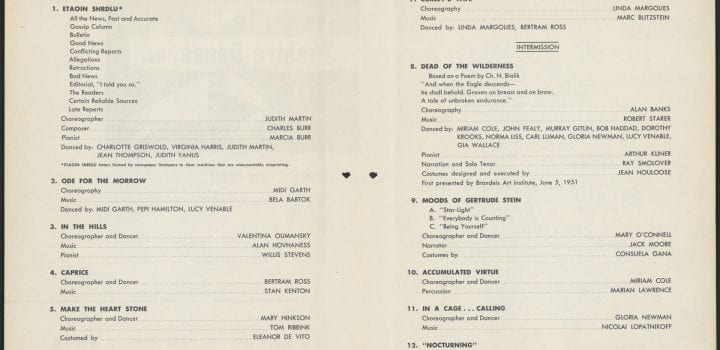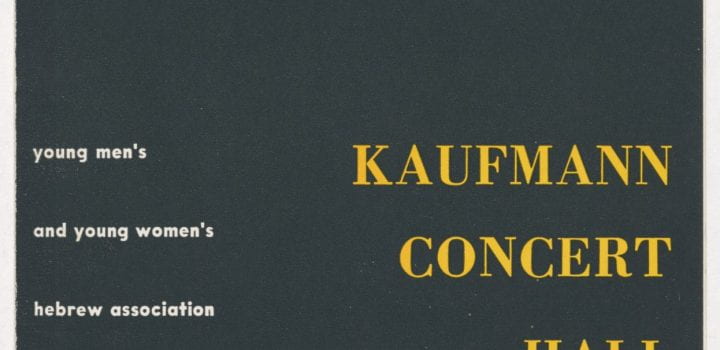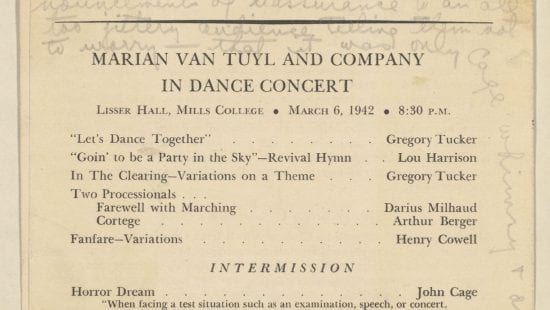Cage and Contemporary Choreographers
As one of the most recognized U.S. experimental composers of the 20th Century, John Cage’s solo work and his collaboration with longtime artistic and romantic partner Merce Cunningham often are emphasized. Yet Cage’s work with other 20th century modern and postmodern choreographers runs a wide span of aesthetics, techniques, and approaches to dance. Cage collaborated with the likes of Pearl Primus, Martha Graham, Hanya Holm, Bonnie Bird, Valerie Bettis, Paul Taylor, and many more.
This section of the exhibit features letters, programs, newspaper clippings (many from scrapbooks prepared by Cage’s mother), and personalized notations emphasizing Cage’s prolific work with a variety of influential choreographers.
Valerie Bettis and Pearl Primus
“The Dance: Growing Up,” New York Times clipping, Dec. 1942
Writer John Martin describes a shared recital by Valerie Bettis and Pearl Primus at New York’s YMHA (later the renowned cultural center, the 92nd Street Y). Cage composed Our Spring Will Come for Primus, which was paired with a speaker reading Langston Hughes’ poetry. For Bettis, he composed And the Earth Shall Bear Again, which Martin describes as “a peasant-like fertility ritual” that “contains some remarkably creative movement and a brilliance of execution.”
Bonnie Bird, Syvilla Fort, and Dorothy Herrmann
Program, “First Concerts,” American Dance Theatre, May 10, 1940
This American Dance Theater “First Concerts” program featured works by Bonnie Bird, Syvilla Fort, and Dorothy Herrmann. Cage composed for Spiritual (performed by Fort), Four Songs of the Moment (performed by Herrmann), Imaginary Landscapes No. 2 (performed by Bird, Fort, Herrmann, and Cole Weston), and the ensemble work America Was Promises. Cage was Bird’s accompanist at the Cornish School of the Arts, where Bird taught after performing with the Martha Graham Dance Company. Merce Cunningham was Bird’s student at Cornish. Fort additionally attended Cornish and later went on to dance for Katherine Dunham, amongst others.
Postcard from Bonnie Bird, 1981
This postcard was sent from longtime collaborator and friend Bonnie Bird to Cage and Cunningham after her trip to Washington state, where the three met at Cornish College of the Arts. She describes her time spent on the San Juan Islands and visiting a Swinomish tribal reservation in La Conner, Washington, which sparks memories of the three friends doing the same in 1939 and 1940.
Trisha Brown
Program, Astral Converted, 1991
Trisha Brown’s Astral Converted was created in collaboration with Cage and Robert Rauschenberg. This program displays the U.S. premiere of the work, which was performed at the National Gallery of Art in Washington D.C. Cage’s score, “Eight,” was titled for the number of instruments called for: flute, oboe, clarinet, bassoon, horn, trumpet, trombone, and tuba.
Daryl Chin and Meredith Monk
Letter from Daryl Chin (on behalf of MoMA) with enclosure from Meredith Monk, August 1980
On June 30, 1980, the New Yorker published a column by dance critic Arlene Croce that traced a faulty lineage amongst many of the Judson artists. She described Robert Wilson as having been “the biggest influence, after Cunningham, on choreographers working today.” Her column’s disavowal of the choreographers preceding Wilson and her scrambling of influences sparked controversy, and triggered responses from Kenneth King, Yvonne Rainer, Zita Allen, and Meredith Monk (included here). While not directly addressing Cage’s work, this series of letters displays the tensions arising from questions of lineage, collaboration, and influence that contributed to the community of artists to which Cage belonged.
Jean Erdman
Program, The Jean Erdman Video Project, 1988
This program from choreographer Jean Erdman’s Video Project includes restaged archival footage from earlier works. Cage collaborated on sound scores for Creature on a Journey (1943), Daughters of the Lonesome Isle (1945), and Ophelia (1946). Cage also served as a guest speaker for the benefit evening of the project, which took place at The Open Eye Theater (co-founded by Erdman) in Margaretville, NY.
Syvilla Fort
Program, Seattle Art League, April 28, 1942
Cage met Fort while she was a student at the Cornish School of the Arts. Fort was the first African American student at Cornish. She later performed with Katherine Dunham until 1945. This program includes handwritten descriptions of the included works. The first-act work Bacchanal was Cage’s first piece for “prepared piano,” a modified piano with an interior that can be manipulated for percussive effects. According to Cage scholar Richard Bunger, Cage devised this innovation during this show when he discovered there was no room for a percussion group in the theatre.
Martha Graham
Program, National Theater, New York City, May 1945
Martha Graham and her dance company performed this program over the span of seven days. Included was the New York premiere of her canonical Appalachian Spring. John Cage composed music for the prepared piano for Merce Cunningham’s Mysterious Adventure, which was included on Graham’s bill. Cunningham was a member of Graham’s company from 1939 until 1945.
Martha Graham, Doris Humphrey, and José Limón
“American Dance” ad, New York Herald Tribune, 1953
Cage and Cunningham’s 16 Dances for Soloist and Company of Three was performed on a collaborative bill including Martha Graham, Doris Humphrey, and José Limón at the Alvin Theatre in New York. 16 Dances was curated with Graham’s Appalachian Spring (1944) and Limón’s The Moor’s Pavane (1949). The program featured over 60 contemporary U.S.-based dancers, labeled the “who’s who of contemporary American dance.”
Anna Halprin
Letter from Anna Halprin, 1992
This letter from Anna Halprin was sent to Cage shortly before his death in 1992. Halprin recounts the earlier years of their friendship, and her husband Lawrence Halprin concludes the letter with a note. Anna Halprin founded the Dancers’ Workshop Company in 1955 just outside of San Francisco, working with dance and sound artists including Simone Forti, Trisha Brown, Yvonne Rainer, Steve Paxton, Terry Riley, La Monte Young, and Warner Jepson. Many of the artists Halprin worked with on the West Coast later moved to New York and contributed to the formation of Judson Dance Theater.
Deborah Hay
Letter from Deborah Hay, undated
This letter was sent to Cage by friend and choreographer Deborah Hay, who was a prominent figure in the Judson era of New York’s downtown dance scene. In the letter, Hay responds to hearing Cage’s Five, performed by a string quartet with trombone in Middleburg, Netherlands. Hay traveled to Middleburg after a 3-week residency at the Center for New Dance Development. Five was composed in 1988 and set for five voices or instruments, each playing within a set range of tones. There is no set score aside from tonal ranges, and each part includes 5 lines with a maximum of 3 notes.
Hanya Holm
Assorted clippings, New York Times, January – March 1944
Cage composed music for Hanya Holm’s Suite of Four Dances, which was performed in January 1944 at the Central High School of Needle Trades. Holm, one of the founders of the Bennington School of the Dance, trained and performed with Mary Wigman, and was one of Valerie Bettis’ teachers. Suite of Four Dances was originally titled What So Proudly We Hail. These clippings also advertise Bettis and Primus’ performances.
Judson Dance Theatre
Judson Program, A Concert of Dance, July 6, 1962
This program marks the first Judson concert, taking place on July 6, 1962 and including works by Cage, Yvonne Rainer, Elaine Summers, Simone Forti, Deborah Hay, Steve Paxton, David Gordon, and more. Thomas J. Lax, co-curator for the recent Museum of Modern Art exhibit, Judson Dance Theater: The Work is Never Done, describes Judson with the following: “Unlike earlier groups of artists associated with Europe’s early-twentieth-century avant-gardes, the various makers who performed at the first Concert of Dance on July 6, 1962, had neither a unified aesthetic nor a political program, functioning without a designated leader. Their story is one of mutual refusal.”
Kenneth King
Letter from Kenneth King, 1985
This 1985 letter from choreographer Kenneth King to Cage thanks him for connecting King to composers and artists David Tudor and Maryanne Amacher. In an earlier 1985 letter from King to Cage, King writes, “Because of continually admiring your work and learning so much from it, and of course from your writings, I am sending this letter to ask some advice about possible leads, companies, corporations, or contacts that might enable me and/or my company to work with the new technologies, possibly in a research capacity, specifically involving video and computers.”
Gertrude Lippincott
Program, “Fifth Annual Modern Dance Concert,” Modern Dance Center, Minneapolis, Feb. 20, 1942
This program displays the works performed under the direction of choreographer Gertrude Lippincott in February, 1942 at the Modern Dance Center in Minneapolis, Minnesota, which Lippincott founded. She was co-editor for the Dance Observer and taught at institutions including Mt. Holyoke College, Mills College, and Louisiana State University. Cage composed for the performance at the Modern Dance Center, along with Florence Goodman Kelty and Marion Roberts.
Marie Marchowsky
New York Times clipping, April 8, 1946
This notice for choreographer Marie Marchowsky’s upcoming performances at Times Hall features her newly-formed company. The program included Marchowsky’s work with accompaniment by contemporary American composers, and featured Foreboding, which included a score composed by Cage.
Merle Marsicano
Program, Theatre Dance, Inc., 92nd Street Y, New York City, Dec. 9, 1951
John Cage composed music and performed with choreographer Merle Marsicano on the work Idyl which was performed at this event.
Paul Taylor
Program, Seven New Dances, Oct. 20, 1957
In addition to many others, Cage composed music for choreographer Paul Taylor. This program for Taylor’s 1957 postmodern work, Seven New Dances, shows Cage collaborating with Taylor, Robert Rauschenberg, Jasper Johns, David Tudor, and Tharon Musser. Composer and choreographer Louis Horst famously wrote a “review” of the work that simply contained the title and location of the performance, followed by inches of blank space. The program was performed at the Kaufman Concert Hall, part of the 92nd Street Y.
Marian Van Tuyl
Program, Mills College, Oakland, Calif., March 6, 1942
Cage composed a number of works for this event, which featured Van Tuyl and the company she directed, the Marian Van Tuyl Dancers. The choreography was performed at Mills College’s dance department, which Van Tuyl founded and directed. Cage composed for Horror Dream and Fads and Fancies in the Academy. Scribbled in the margins of the program is a story recounting the concern generated during rehearsal by a recorded sound mistaken for an air raid siren.

